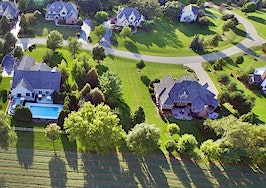- The new FAA drone regulations went into effect Monday, August 29.
- The new rules make it easier for real estate agents to get aerial photos and video for listings.
- Drone pilots must register their drones and apply for the FAA form 8710-13.
The Federal Aviation Administration (FAA) laid out new regulations for drone usage back in June that went into effect August 26.
But who was actually following the rules, anyway?
The new regulations make drone flight much easier for the entry-level pilot.
[Tweet “New FAA drone laws took effect Aug. 29: Let’s fly!”]
One of the biggest improvements to the regulations is lack of requirement for the section 333 waiver. The section 333 waiver was issued by the FAA and was the first attempt at monitoring flight patterns and regulating commercial drone usage.
Shortly after the new regulations were announced in June, the FAA shut down the section 333 waiver portal on its website.
“Realtors pushed hard to make the new FAA rules a reality, and we’re excited for the opportunity they represent,” said NAR president Tom Salomone.
“This regulatory landscape creates a much clearer pathway for the use of drones in real estate, and eliminating the requirement that drone operators hold a pilot’s license makes it all that much more accessible to potential operators.”
How to legally fly your drone
First, you must be 16 years old to operate a unmanned aerial vehicle (UAV). You must also pass the aeronautical knowledge test at an FAA-approved knowledge testing center.
You must also be able to read, speak, write and understand English, although exceptions are made you are unable to meet one of these requirements based on medical reasons. Then you must complete the FAA form 8710-13 for a remote pilot certificate.
The new regulations are in place for small UAVs — those weighing less than 55 pounds. This includes situations where the pilot is transporting property for compensation (for example, Amazon drone delivery service, Domino’s pizza drone delivery, etc.).
“Moving forward, we’re looking ahead to a rule-making specifically for the ‘micro’ category of small drones that are commonly used for real estate purposes. That’s something we’d like to see happen and we’re regularly in touch with the FAA about ways we can further improve the process for safe, responsible operators,” Salomone said.
[Tweet “You still need to register your drone, but you can fly freely”]
Under part 107, the FAA’s summary of rules for small unmanned aircrafts, it is written that you may not fly at night.
There is an exception for 30 minutes prior to sunrise and the 30 minutes following sunset.
But even with all these regulations, the FAA still wields the power to waive the rules.
If, for example, the best shot of a building is at night, then you may apply for the waiver through the FAA online portal.
You must also have a remote pilot to act as a spotter for the drone. A visual line of sight must always be maintained between the pilot and the UAV. (The National Association of Realtors argued against this regulation to help accommodate aerial photography for tall buildings.)
You may not fly your UAV higher than 400 feet. You may also not fly faster than 100 mph.
You may not fly over crowds of people (for example, at sporting events, community festivals or other gatherings).
Some safety tips for drone photos and video
Before each flight, be sure to do a full check-up on your drone and surroundings:
[Tweet “Pre-flight safety check is required – now video that house from 399 feet!”]
- Are the propellors tight enough?
- Are your batteries fully charged?
- Is the landing gear secured?
- If applicable, is the camera/gimbal rig operating properly?
- Are the directional lights functioning properly?
- If applicable, have you properly GPS-coordinated your drone for flight?
- Is the take-off area clear of obstructions, such as power lines, trees or otherwise?
- Knowing your flight pattern, will you be able to maintain visual line of sight for the entire flight?
- Are there large groups of people nearby?
Some tips for great aerial photography and video
Once you get over the initial joy of piloting a drone (the joy is fleeting as the fear of crashing becomes more real), the next step is mastery of shots.
Here are some things to keep in mind when shooting your property:
- What exciting characteristics of the neighborhood can you show relative proximity to with aerial photography? If the home is close to a baseball field or a foodie district, include that in the photo!
- Slow, smooth video shots really showcase a property and give the viewer time to soak in all that the house has to offer. Don’t assume fast fly-bys show more of the area in less time.
- Sunrise and sunset are when you’ll have the best natural light for photos. Too late and it may be too dark, and midday means your exposure will blow out the sky.
- Directly overhead photos are the best way to showcase the space, but not the house. For a great home portrait, keep your drone between 20 and 40 feet above the roofline.
- Post-production for aerial photography is crucial! Raw aerial photos look great on your phone, but cleaning them up is not easy. Some drones come with cameras bragging “170-degrees of view,” which makes for really wide photos. And some of these are shooting in 4K resolution! When you distort, or un-distort, the fish-eye view, the 4K resolution allows you to zoom in with crystal clear precision.






